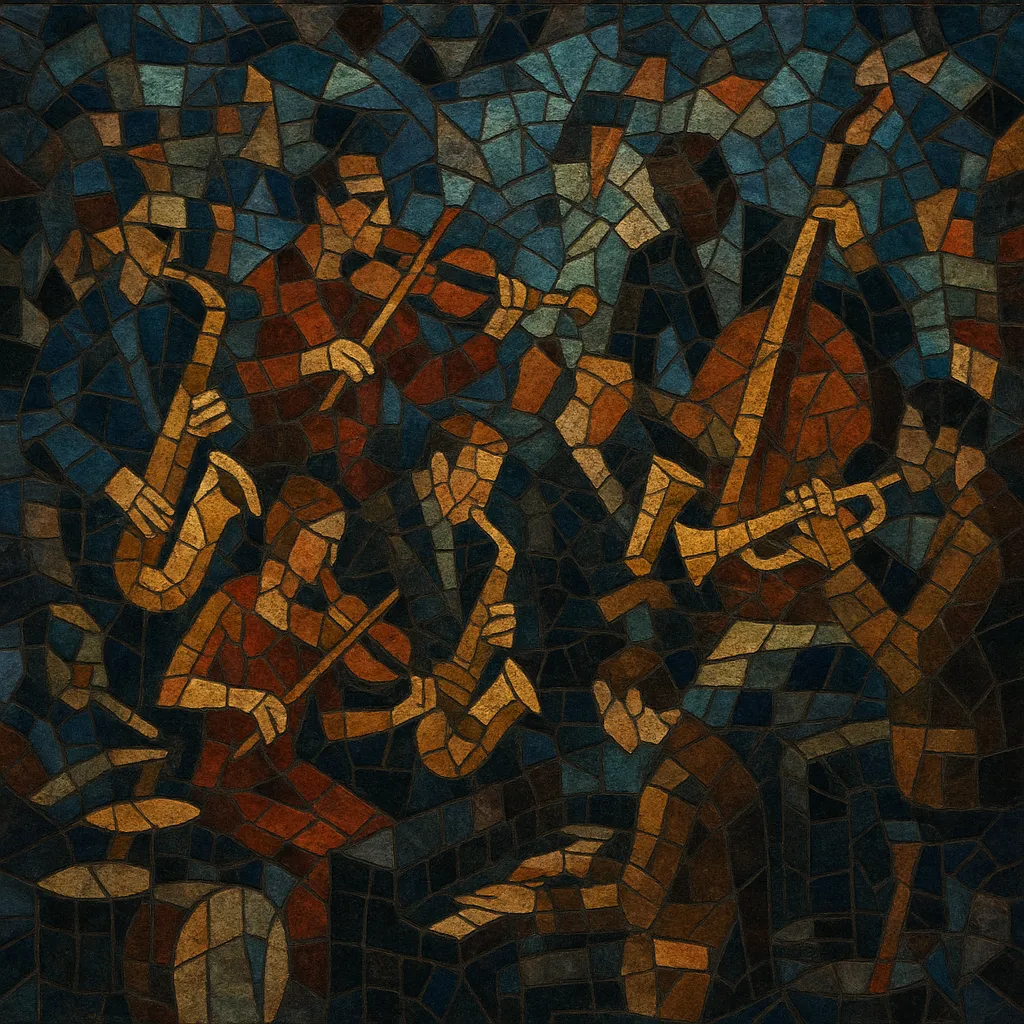Experimental big band is a forward-looking offshoot of the jazz big band tradition that applies avant‑garde composition, free improvisation, and nonstandard orchestrations to the classic large‑ensemble format.
While it often retains a core lineup of saxophones, trumpets, trombones, and rhythm section, it commonly expands the palette with woodwind doublings, strings, electronics, unconventional percussion, and voice. Harmony ranges from extended tonal and modal writing to polytonality and atonality, often employing quartal/quintal harmony, tone clusters, and timbral (color‑based) harmonies. Rhythm favors odd meters, polyrhythms, metric modulation, and groove/texture hybrids. Forms may be through‑composed, modular, or suite‑like, and pieces frequently integrate conducted or cued improvisation, graphic notation, and other experimental score practices.
Rather than a single codified style, experimental big band functions as an umbrella for large ensembles that push beyond swing and post‑bop arranging by drawing on contemporary classical approaches, free jazz, minimalism, electronics, and global traditions.
Experimental big band crystallized in the United States during the 1950s, when bandleaders and arrangers began extending the harmonic, formal, and timbral vocabulary of swing and bop‑era orchestras. Stan Kenton’s Innovations in Modern Music Orchestra and the advanced writing of George Russell and Gil Evans introduced sophisticated harmonic systems, expanded instrumentation, and through‑composed forms to the big band context.
The 1960s brought sustained interaction with free jazz and contemporary classical music. Sun Ra’s Arkestra fused big‑band energy with Afrofuturist concepts, electronics, and collective improvisation. Charles Mingus’s ensembles blurred composition and spontaneous arrangement. In parallel, third stream thinking (jazz–classical synthesis) encouraged the use of orchestral colors, extended techniques, and nonfunctional harmony. In Europe, large free‑improv collectives such as the Globe Unity Orchestra modeled a big‑band‑scale approach to open form, while composers like Carla Bley and Anthony Braxton created ambitious, modular works for creative orchestras.
By the late 20th century, experimental big band practices had diffused through conservatories and international scenes. European groups (e.g., Vienna Art Orchestra) and American ensembles alike embraced mixed notation, unusual doublings, non‑Western percussion, and studio techniques. Advanced arranging for large ensembles became a recognized contemporary jazz discipline, supported by commissions and festivals.
In the 2000s and beyond, composers such as Maria Schneider, Darcy James Argue, and John Hollenbeck revitalized the idiom with long‑form narratives, environmental soundscapes, post‑minimalist processes, electronics, and cross‑genre references. Today, experimental big band is a global practice that treats the large jazz orchestra as a flexible laboratory for color, rhythm, space, and collective improvisation.
Start with a traditional big band core (4–5 saxophones with doubles, 4 trombones, 4–5 trumpets, piano/keys, guitar, bass, drums). Expand timbres with flutes/clarinets/bass clarinet, euphonium/tuba, strings, voice, mallet percussion, world percussion, and electronics.
Write beyond functional harmony. Combine modal and quartal/quintal structures with polytonal or atonal passages. Use clusters, pedal points, and spectral color chords. Craft melodies that can withstand reharmonization and layering; consider modular themes that recombine across movements.
Employ asymmetrical meters, polyrhythms, metric modulation, and textural ostinati. Alternate groove‑based sections with open time and rubato. Favor multi‑movement suites, through‑composed arcs, or modular blocks that can be reordered via cues.
Exploit sectional contrasts (saxes vs. brass vs. mixed choirs) and unconventional pairings (e.g., bass clarinet with muted trombones). Use mutes, flutter‑tongue, breath tones, harmonics, overpressure, and other extended techniques. Orchestrate for timbral counterpoint—let colors, not only pitches, drive voice‑leading.
Design improvisation as part of the architecture: solo over evolving pedal fields, free episodes framed by hits, or collective improvisation guided by cue cards/hand signals. Consider conducted improvisation to shape density, register, and dynamics in real time.
Layer live electronics (synths, samplers, processing) subtly to extend color, or foreground them as equal partners. In the studio, use close miking and selective reverb to sculpt depth; embrace overdubs or tape techniques if they serve the composition.
Combine traditional notation with graphic elements and prose instructions where precision isn’t essential. Provide clear cues, roadmaps, and rehearsal letters for flexible sections. Rehearse balance and blend meticulously; dynamic nuance and articulation are crucial when textures grow dense.


